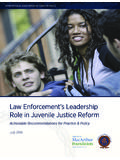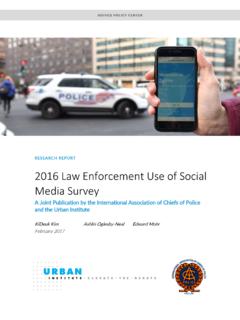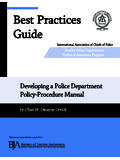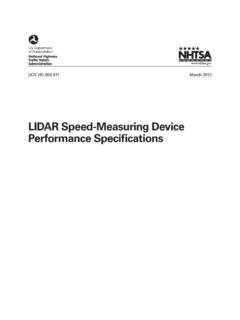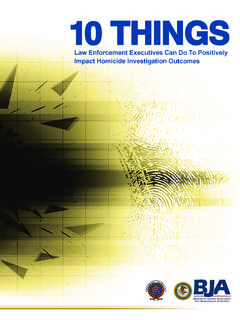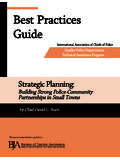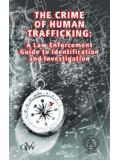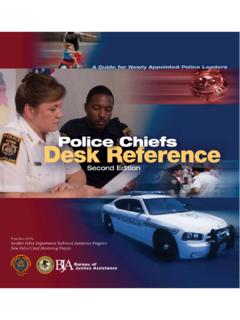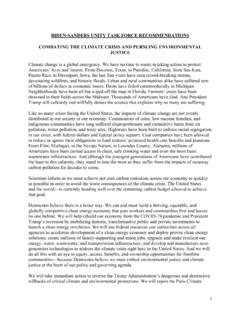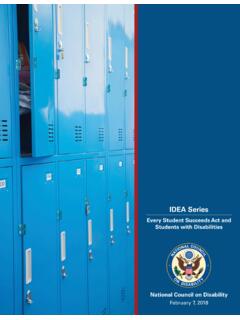Transcription of National Consensus Policy on Use of Force
1 National . Consensus . Policy AND. DISCUSSION. PAPER ON USE OF. Force . Revised July 2020. (Originally published October 2017). Policy . This National Consensus Policy on Use of Force is a collaborative effort among 11 of the most significant law enforcement leadership and labor organizations in the United States (see back panel for list). The Policy reflects the best thinking of all Consensus organizations and is solely intended to serve as a template for law enforcement agencies to compare and enhance their existing policies. I. PURPOSE III. DEFINITIONS. The purpose of this Policy is to provide law DEADLY Force : Any use of Force that creates enforcement officers with guidelines for the use a substantial risk of causing death or serious of less-lethal and deadly Force .
2 Bodily injury. LESS-LETHAL Force : Any use of Force other than II. Policy that which is considered deadly Force that involves It is the Policy of this law enforcement agency to physical effort to control, restrain, or overcome the value and preserve human life. Officers shall use resistance of another. only the Force that is objectively reasonable to effectively bring an incident under control, while OBJECTIVELY REASONABLE: The determination protecting the safety of the officer and others. that the necessity for using Force and the level of Officers shall use Force only when no reasonably Force used is based upon the officer's evaluation effective alternative appears to exist and shall of the situation in light of the totality of the use only the level of Force which a reasonably circumstances known to the officer at the time prudent officer would use under the same or the Force is used and upon what a reasonably similar circumstances.
3 Prudent officer would use under the same or similar situations. The decision to use Force requires careful attention to the facts and circumstances of each particular SERIOUS BODILY INJURY: Injury that involves a case, including the severity of the crime at issue, substantial risk of death, protracted and obvious whether the suspect poses an immediate threat to disfigurement, or extended loss or impairment of the safety of the officer or others, and whether he the function of a body part or organ. is actively resisting arrest or attempting to evade DE-ESCALATION: Taking action or communicating arrest by flight.. verbally or non-verbally during a potential Force In addition, the reasonableness' of a particular use encounter in an attempt to stabilize the situation of Force must be judged from the perspective of a and reduce the immediacy of the threat so that more reasonable officer on the scene, rather than with the time, options, and resources can be called upon to 20/20 vision of hindsight the question is whether the resolve the situation without the use of Force or with officers' actions are objectively reasonable' in light of a reduction in the Force necessary.
4 De-escalation the facts and circumstances confronting them. 1 may include the use of such techniques as command presence, advisements, warnings, verbal persuasion, This Policy is to be reviewed annually and any and tactical repositioning. questions or concerns should be addressed to the immediate supervisor for clarification. EXIGENT CIRCUMSTANCES: Those circumstances that would cause a reasonable person to believe that a particular action is necessary to prevent physical 1 Graham v. Connor, 490 386 (1989). National Consensus DOCUMENTS ON USE OF Force 2. harm to an individual, the destruction of 4. An officer has a duty to intervene to prevent or relevant evidence, the escape of a suspect, or stop the use of excessive Force by another some other consequence improperly frustrating officer when it is safe and reasonable to do so.
5 Legitimate law enforcement 5. All uses of Force shall be documented and investigated pursuant to this agency's CHOKE HOLD: A physical maneuver that restricts policies. an individual's ability to breathe for the purposes of incapacitation. B. De-escalation 1. An officer shall use de-escalation techniques VASCULAR NECK RESTRAINT: A technique that and other alternatives to higher levels of Force can be used to incapacitate individuals by consistent with his or her training whenever restricting the flow of blood to their brain. possible and appropriate before resorting to WARNING SHOT: Discharge of a firearm Force and to reduce the need for Force . for the purpose of compelling 2. Whenever possible and when such delay will compliance from an individual, but not not compromise the safety of the officer or intended to cause physical injury.
6 Another and will not result in the destruction of evidence, escape of a suspect, or IV. PROCEDURES commission of a crime, an officer shall allow an individual time and opportunity to submit A. General Provisions to verbal commands before Force is used. 1. Use of physical Force should be C. Use of Less-Lethal Force discontinued when resistance ceases or when the incident is under control. When de-escalation techniques are not effective or appropriate, an officer may 2. Physical Force shall not be used against consider the use of less-lethal Force to individuals in restraints, except as control a non-compliant or actively resistant objectively reasonable to prevent their individual.
7 An officer is authorized to use escape or prevent imminent bodily agency-approved, less-lethal Force injury to the individual, the officer, or techniques and issued equipment another person. In these situations, only the minimal amount of Force 1. to protect the officer or others from necessary to control the situation shall immediate physical harm, be used. 2. to restrain or subdue an individual who is 3. Once the scene is safe and as soon actively resisting or evading arrest, or as practical, an officer shall 3. to bring an unlawful situation safely and provide effectively under control. appropriate medical care consistent with his or her training to any D. Use of Deadly Force individual who has visible injuries, 1.
8 An officer is authorized to use deadly Force complains of being injured, or requests when it is objectively reasonable under the medical attention. totality of the circumstances. Use of deadly This may include providing first aid, Force is justified when one or both of the requesting emergency medical services, following apply: and/or arranging for transportation to a. to protect the officer or others from an emergency medical facility. what is reasonably believed to be an 2 2 Based on the definition from United States v. McConney, 728 1195, 1199 (9th Cir.), cert. denied, 469 824 (1984). National Consensus DOCUMENTS ON USE OF Force 3. immediate threat of death or person with deadly Force by means serious bodily injury other than the vehicle; or b.
9 To prevent the escape of a fleeing (2) the vehicle is operated in a manner subject when the officer has probable deliberately intended to strike an cause to believe that the person has officer or another person, and all committed, or intends to commit a other reasonable means of defense felony involving serious bodily injury have been exhausted (or are not or death, and the officer reasonably present or practical), which believes that there is an imminent risk includes moving out of the path of of serious bodily injury or death to the the vehicle. officer or another if the subject is not d. Firearms shall not be discharged from immediately apprehended a moving vehicle except in exigent 2.
10 Where feasible, the officer shall identify circumstances. In these situations, an himself or herself as a law enforcement officer must have an articulable reason officer and warn of his or her intent to for this use of deadly Force . use deadly e. Choke holds are prohibited unless 3. Deadly Force Restrictions deadly Force is authorized. a. Deadly Force should not be used E. Training against persons whose actions are a threat only to themselves or property. 1. All officers shall receive training, at least annually, on this agency's use of Force b. Warning shots are inherently Policy and related legal updates. dangerous. Therefore, a warning shot must have a defined target and shall 2.
